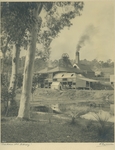Seaham No.1 Colliery, New South Wales
This image is provided for research purposes only and must not be reproduced without the prior permission of the Archives Program, Australian National University.
![]() Download (87.82 MB)
Download (87.82 MB)

| dc.contributor.other | Cazneaux, Harold (Pierce), 1878-1953 | |
|---|---|---|
| dc.coverage.spatial | Seaham, New South Wales | |
| dc.date.accessioned | 2004-02-25T03:20:11Z | |
| dc.date.accessioned | 2011-01-05T09:55:10Z | |
| dc.date.available | 2004-02-25T03:20:11Z | |
| dc.date.available | 2011-01-05T09:55:10Z | |
| dc.date.created | 1925 | |
| dc.identifier.uri | http://hdl.handle.net/1885/16 | |
| dc.identifier.uri | http://digitalcollections.anu.edu.au/handle/1885/558611 | |
| dc.description.abstract | Two eucalypts frame a view of colliery buildings and structures on the far side of a stretch of water. The mining equipment visible includes a winding wheel and a chimney emitting smoke. This is one of two Seaham collieries which produced high quality steam coal from the Borehole seam. Cazneaux printed this image from a photograph he took for one of the many projects assigned to him by the art firm of (Ure) Smith and (Harry) Julius. He and artist, Albert Collins (died 1951) created the illustrations for a souvenir volume for Abermain Seaham Collieries. This image differs from that on page 41 of the book by being more closely cropped. Cropping was one of the techniques used by Pictorialist photographers like Cazneaux to create compositions that resembled artworks made in more traditional media. The print is in the Adelaide Steamship Company's collection because in 1905 the company acquired large interests in the Abermain Colliery (near Maitland), the Seaham Colliery (near Newcastle) and the North Bulli Mine (near Wollongong) in order to secure its source of bunkering coal - a move that was to prove advantageous when the price of British steamering coal rose dramatically in 1908. The interests of the Abermain and Seaham collieries merged in 1922 and in 1931 a further merger created J. & A. Brown & Abermain Seaham. The Adelaide Steamship Company remained the mining company's largest shareholder. | |
| dc.format.extent | 89924176 bytes | |
| dc.format.medium | Black and white photograph | |
| dc.format.medium | 24.9cm x 20cm | |
| dc.format.mimetype | image/tiff | |
| dc.language.iso | en_AU | |
| dc.publisher | Abermain & Seaham Coals; Sydney: Abermain Seaham Collieries, 1925 (Sydney: Pratten Bros.) This image differs from that on page 41 by being more closely cropped. | |
| dc.relation.ispartof | Adelaide Steamship Company | |
| dc.relation.ispartof | Noel Butlin Archives Centre. ANU Archives Program. | |
| dc.relation.ispartofseries | Album of eight photographs of Abermain and Seaham Collieries, Hunter River, and Newcastle wharves, beach and harbour taken by Harold Pierce Cazneaux, 1925. | |
| dc.rights | This image is provided for research purposes only and must not be reproduced without the prior permission of the Archives Program, Australian National University. | |
| dc.subject.other | Photographs | |
| dc.subject.other | industrial photography | |
| dc.subject.other | coalmines | |
| dc.subject.other | coal industry | |
| dc.subject.other | buildings, structures & establishments | |
| dc.subject.other | industrial buildings | |
| dc.subject.other | industrial equipment | |
| dc.subject.other | plant (industrial) | |
| dc.subject.other | derricks | |
| dc.subject.other | lift shafts | |
| dc.subject.other | chimneys | |
| dc.subject.other | smoke | |
| dc.subject.other | wheels | |
| dc.subject.other | industrial area | |
| dc.subject.other | grasses | |
| dc.subject.other | eucalypts | |
| dc.subject.other | Abermain Seaham Collieries Limited | |
| dc.title | Seaham No.1 Colliery, New South Wales | |
| dc.type | Image | |
| local.description.notes | Inscribed in white on image, l.l.: 1925. | |
| local.description.notes | inscribed in pencil below image, l.l.: 'Seaham No 1. Colliery.' | |
| local.description.notes | inscribed in pencil below image, l.r.: H Cazneaux | |
| local.description.notes | Cazneaux printed this image from a photograph he took for one of the many projects assigned to him by the art firm of Smith and Julius. He and artist, Albert Collins (died 1951) created the illustrations for a souvenir volume: Abermain & Seaham Coals, published by Abermain Seaham Collieries Limited, Sydney, 1925. This image differs from that on page by being more closely cropped. Cropping was one of the techniques used by Pictorialist photographers like Cazneaux to create compositions that resembled artworks made in more traditional media. | |
| local.citation | N046-114-01 | |
| Collections | Photographs : Harold Cazneaux | |
Download
| File | Description | Size | Format | Image |
|---|---|---|---|---|
| N046-114-01.tif | 87.82 MB | TIFF |  |
Items in Open Research are protected by copyright, with all rights reserved, unless otherwise indicated.
Updated: 17 November 2022/ Responsible Officer: University Librarian/ Page Contact: Library Systems & Web Coordinator








